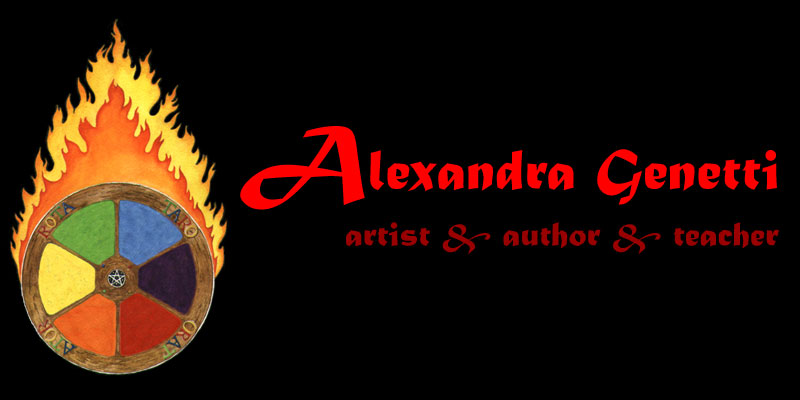The Devil - Wheel of Change Tarot
The Devil is the final card in the four-card series that represents the solar stations of the year. He is the wild king of the autumn equinox, when the light of the year is fading and the bounty of the harvest has arrived. His are the unrestrained pleasures of life, when wine and beer are made and when people retreat from their outdoor life and return to the harvest home and the joy of the September bounty. The Emperor—who believes in the supreme authority of the ruler and the infallibility of his direction—now gives way to the Devil, who believes in anarchy and complete individual freedom. This is the contrast between the organized community work of the late winter and spring, ploughing and planting, and the chaos of the harvest festival, when the produce is brought inside and the kitchen is busy with the smells of food. The family now prepares to retreat to the inner life of the home and more hours of darkness for the pleasures of the bed. The Devil’s autumn world is one of amazing commotion, freedom, and uninhibited sexuality in the concealment of autumn’s shadows.
In the card the eyes of the Devil draw you into his world, the world of nature with its wildness, diversity, and sometimes frightening darkness. The trees in the card are bound with ivy, just as lovers entwine in the sexual act. Yet the ivy will, in nature’s time, be the cause of the trees’ downfall. This is akin to the powerful goddess of nature, who gives us birth and then cuts us down in death. The Devil embraces all of nature; he is comfortable with its destructive qualities as well as its pleasurable ones. He revels in the death of the rabbit as the hawk snatches it from the field; he watches with glee when the bucks bloody each other over the doe. Then, he takes intimate pleasure in the buck’s mounting of the doe, and beats the drum in the rhythm of his thrusting. The drum symbolizes the heartbeat and the rhythm of nature; it is the repetition of cycles through time. Although we seldom recognize it, we too are in tune with the rhythm of nature because we are a part of it. Our bodies pulse with the beating of our hearts; we are born and then die in rhythm with the world of nature around us. (see Mickey Hart, "Planet Drum" pg. 17: a marvelous paragraph on entrainment and rhythm in nature)
Autumn is the season of harvest, and yet, as the bounty of produce is stored and processed, the darkness of the season increases and the cold creeps in. These are the natural processes that the Devil responds to; the extremes of the year are both represented in the fall: its joy and sorrow, strength and fear. The Devil symbolizes our attachment to the emotional experience of extremes. As a culture we are drawn to the darkest tales of human depravity for the emotional ride they give us. We are also drawn to the storybook fairy-tale happy ending as the other extreme of this. The Devil is the fulfillment of our desires, the attachment we have to our lives, and the drowning in the pain and pleasure of the senses. He revels in the experience of drunkenness with the vine and the mushroom. He loves the sexual experience and will be just as inquisitive there, for it is his desire to experience the full range of human possibility.
In recent Christian times the experience of nature as primitive, sexual, and dark was opposed to the creation of the pure idea world of God. Attachment to the pleasures of the body was a sin to be mortified, and these sins were associated with the Devil, God’s fallen angel, who was opposed to Christ in every way. Christ is the Christian incarnation of the Emperor, the lawgiving king of the light half of the year; he represents the human world of mind. The Devil is the king of the growing darkness and the wild world of nature and the body. In ancient times the Devil was called Pan or Dionysus, and his revels drew hordes to enjoy the experiences of excess and the pleasures of the body.
The negative meanings of the Devil are obvious. Over-attachment to intense experience can bring tragedy into one’s life as drug abuse, alcoholism, or even horrible criminal acts that hurt others. Anything that brings with it emotional ecstasy or its opposite is an experience of the Devil card. The key to insight is that we recognize the difference between use and abuse and learn not to let our own excesses hurt others around us.
When the Devil is a part of your reading, you are in the midst of an intense situation. Perhaps you are experiencing (possibly in excess) the pleasures and pains of living, in yourself or in those around you. Possibly, when you draw the Devil, the situation calls for more emotional engagement. Maybe it is a time to examine your attachments and learn the lesson of moderation. Look around you and really see the part you play in the natural world. Learn to feel a part of it and recognize the rhythms of life in your body and the world around you. In recognizing the natural rhythms you will find that the times for excess and the times for abstinence are a part of the natural world. Whatever else it is, the Devil is first and foremost the symbol of the pleasures of life. In these things we are called on to recognize that our emotions are the measure of our living and the Devil is the symbol of the authentic experience.
BACK to main Wheel of Change Tarot page

